MASS COMMUNICATION AND JOURNALISM
Paper – II
Note : This paper contains fifty (50) objective type questions of two (2) marks each. All questions are compulsory.
1. According to critics, effects models are problematic as they are
(1) Real
(2) Hypothetical
(3) Traditional
(4) Normative
2. In communication, relational information is
(1) non-interpretative
(2) uncritical
(3) non-transferable
(4) emotional
3. Media of the third degree contain _______ processed forms of representation .
(1) personally
(2) impersonally
(3) digitally
(4) conventionally
4. Media texts are considered as
(1) passive
(2) static
(3) dynamic
(4) negative
5. The theory of frame analysis was developed by
(1) Erving Goffman
(2) Samuel Huntington
(3) F. Inglis
(4) Carl Hovland
6. Identify the researcher who distinguished the functions of mass media as manifest and latent.
(1) Robert Merton
(2) Charles W. Wright
(3) P.J. Tichenor
(4) G. Tuchman
7. One of the barriers to persuasive communication is
(1) Income
(2) Level of education
(3) Age
(4) Religion
8. The most important limitation of information-flow theory is
(1) Message-centric
(2) Source-dominance
(3) Channel problem
(4) Receiver-specific
9. The organization, International Freedom of Expression Exchange, is located in
(1) the USA
(2) the UK
(3) Australia
(4) Canada
10. Section 499 of Indian Penal Code (IPC) contains the criminal liability of
(1) copyright
(2) contempt of court
(3) defamation
(4) sedition
11. In cases of copyright violation, the interlocutory injunction is considered as a ______ remedy.
(1) Final
(2) Constitutional
(3) Non-conforming
(4) Discretionary
12. The object of the Press and Registration of Books Act, 1867, is merely to regulate ______ for preservation of copies of books and newspapers.
(1) Printing presses
(2) Publishers
(3) Printers
(4) Authors
13. The memorandum to control the selection of newspapers for ______ by the Indian government was challenged in the Calcutta High Court by print media during the period of internal emergency (1975-76).
(1) Public advertisements
(2) Newsprint quota
(3) Accreditation
(4) Government benefits
14. The major strategy of participatory communication is
(1) Government scheme
(2) Top-down approach
(3) Information dissemination
(4) Dialogue
15. Los Banos School is associated with
(1) Cultural communication
(2) Development communication
(3) Risk communication
(4) International communication
16. A quantitative aggregation of findings of many research efforts will result in
(1) Meta analysis
(2) Gatekeeping and unit analysis
(3) Output analysis
(4) Input analysis
17. A construct is
(1) Incomplete in presentation
(2) A false statement
(3) A personal statement
(4) An abstract statement
18. A discreet variable cannot be divided into
(1) values
(2) phenomena
(3) groups
(4) sub-parts
19. The difference between sample and population values will show
(1) the range
(2) the statistical significance
(3) the sampling error
(4) the stratified deviation
20. Which document describes your needed camera set-ups ?
(1) Shot list
(2) Rule of Thirds
(3) Script
(4) Synopsis
21. The button at the top of the camera used to take the picture is called
(1) Shutter Speed
(2) Shutter Release
(3) Camera Body
(4) Lens
22. A text matter that accompanies a photograph is ______ :
(1) Headline
(2) By-line
(3) Date-line
(4) Cut-line
23. A premium rate for a special position to advertise is known as
(1) Make-good rate
(2) Impact rate
(3) Mandatory rate
(4) Loading rate
24. Communication audit is commonly employed in the field of
(1) Advertising
(2) Public relations
(3) Newspaper publishing
(4) Broadcasting
25. Gravure printing method is
(1) Black and white only
(2) Intaglio printing
(3) Thermal printing
(4) Flexographic printing
26. RGB colour model is known as ______ colour model.
(1) Additive
(2) Subtractive
(3) Restrictive
(4) Non-active
27. Robert Gunning’s readability formula attempts to identify the level of ______ in a piece of text.
(1) Fog
(2) Excellence
(3) Codification
(4) Abstraction
28. Assertion (A) : In the practice of his or her professional activities, a public relations practitioner should respect the collective dignity of the publics, but not of individuals.
Reason (R) : It is his/her responsibility to deal properly with everyone around that includes colleagues, employer, media and public at large.
Codes :
(1) Both (A) and (R) are true.
(2) Both (A) and (R) are true, but (R) is not the correct explanation of (A).
(3) (A) is true, but (R) is false.
(4) (A) is false, but (R) is true.
29. Assertion (A) : A public relations practitioner should maintain the highest level of professionalism to achieve the specific targets identified.
Reason (R) : For this, he or she should manage and manipulate the media outlets.
Codes :
(1) Both (A) and (R) are true.
(2) Both (A) and (R) are true, but (R) is not the correct explanation of (A).
(3) (A) is true, but (R) is false.
(4) (A) is false, but (R) is true.
30. Assertion (A) : The impact of paid sales message is an additional worry for marketing communicators.
Reason (R) : The increased commercial contents in mass media make the audience tune them out because of their noise level.
Codes :
(1) Both (A) and (R) are true.
(2) Both (A) and (R) are true, but (R) is not the correct explanation of (A).
(3) (A) is true, but (R) is false.
(4) (A) is false, but (R) is true.
31. Assertion (A) : The concept of linear modernisation is still popular among power elites across the globe.
Reason (R) : It helps them expand and sustain their hold on power by their control of capitalistic means.
Codes :
(1) Both (A) and (R) are true.
(2) Both (A) and (R) are true, but (R) is not the correct explanation of (A).
(3) (A) is true, but (R) is false.
(4) (A) is false, but (R) is true.
32. Assertion (A) : RTI has become a new source of news and information.
Reason (R) : Earlier government officers were not allowed to provide information to journalists.
Codes :
(1) Both (A) and (R) are true.
(2) Both (A) and (R) are true, but (R) is not the correct explanation of (A).
(3) (A) is true, but (R) is false.
(4) (A) is false, but (R) is true.
33. Assertion (A) : Single screen cinemas are disappearing fast in India.
Reason (R) : Because malls are being constructed in their place.
Codes :
(1) Both (A) and (R) are true and (R) is the correct explanation of (A).
(2) Both (A) and (R) are true, but (R) is not the correct explanation of (A).
(3) (A) is true, but (R) is false.
(4) (A) is false, but (R) is true.
34. Assertion (A) : Radio plays are different from TV plays because radio plays have no actors in them.
Reason (R) : Because radio is a blind medium.
Codes :
(1) Both (A) and (R) are correct, but (R) is not the correct explanation of (A).
(2) Both (A) and (R) are correct and (R) is the correct explanation of (A).
(3) (A) is correct, but (R) is false.
(4) (A) is false, but (R) is correct.
35. Assertion (A) : Citizen journalism is different from professional journalism.
Reason (R) : Professional journalists do not use social media to disseminate their stories.
Codes :
(1) Both (A) and (R) are correct, but (R) is not the correct explanation of (A).
(2) Both (A) and (R) are correct and (R) is the correct explanation of (A).
(3) (A) is true, but (R) is false.
(4) (A) is false, but (R) is true.
36. Identify the chronological sequence of following AIR broadcasts :
(1) Vividh Bharathi, School broadcasts, External services, Rural broadcasts
(2) School broadcasts, Rural broadcasts, Vividh Bharathi, External services
(3) External services, Vividh Bharathi, Rural broadcasts, School broadcasts
(4) Rural broadcasts, External services, School broadcasts, Vividh Bharathi
37. Identify the correct sequence of the following codes :
(1) Hays Code, Fairness Doctrine, Code of Athens, ASCI Code
(2) ASCI Code, Hays Code, Fairness Doctrine, Code of Athens
(3) Fairness Doctrine, Code of Athens, ASCI Code, Hays Code
(4) Code of Athens, ASCI Code, Hays Code, Fairness Doctrine
38. Identify the correct sequence of feminist media perception advocates :
(1) Margaret Gallagher, A.N. Valdivia, G. Tuchman, Betty Friedan
(2) A.N. Valdivia, G. Tuchman, Betty Friedan, Margaret Gallagher
(3) G. Tuchman, Betty Friedan, Margaret Gallagher, A.N. Valdivia
(4) Betty Friedan, G. Tuchman, Margaret Gallagher, A.N. Valdivia
39. Identify the correct sequence of following news agencies that operated in India :
(1) Free Press, Reuters, Associated Press of India, United Press of India
(2) Reuters, Associated Press of India, Free Press, United Press of India
(3) Associated Press of India, United Press of India, Reuters, Free Press
(4) United Press of India, Reuters, Associated Press of India, Free Press
40. Write the correct chronological order of the following social media platforms :
(1) Linkedin, facebook, youtube, twitter
(2) facebook, youtube, twitter, Linkedin
(3) youtube, twitter, Linkedin, facebook
(4) twitter, Linkedin, facebook, youtube
41. Match List – I with List – II :
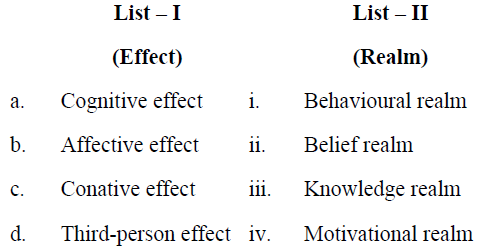

42. Match List – I with List – II :

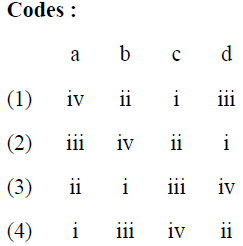
43. Match the following :


44. Match the following tag line :
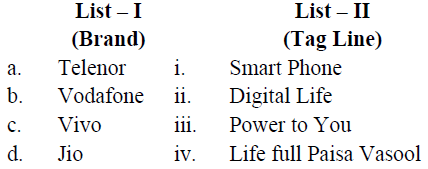
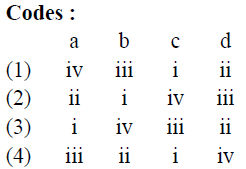
45. Match List – I with List – II :
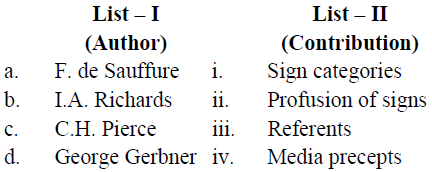
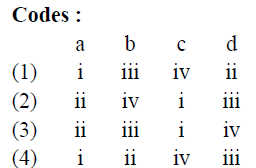
Read the following passage and answer questions from 46 to 50 :
Brands have been around since ancient times. In 3000 BC, in Ancient Egypt, symbols were used to identify the bricks leading to pharaoh tombs; in 2000 BC, in ancient Palestine, signs were employed to distinguish pottery. The word brand comes from the Old Norse word brandr (North Germanic language of the Scandinavian peoples prior to 1350 AD) which means ‘to burn’ or, more specifically, to mark livestock. According to a widely accepted definition, a brand is a name, term, sign, symbol, or design, or a combination of these elements intended to identify and differentiate a product in the minds of concerned subjects. According to this definition, there are four ingredients which characterize a brand. Firstly, a brand consists of names, symbols, designs, or any other feature, which constitute its brand elements. These brand elements refer to the logotype, packaging and other tangible constituent parts of a product. Secondly, brands identify and differentiate a branded product, both roles being the fundamental functions of a brand. A brand identifies the goods and services of a seller and attests the product’s source. dentification is objective; it relies only on the capacity of names, symbols, designs and any other external cue to describe or insinuate where the offering comes from. Other than the purpose of identification, a brand differentiates the seller’s offering from that of competitors. Contrary to identification, differentiation is subjective and depends on consumers’ perceptions, attitudes and behaviour towards the brand. Differentiation does not occur just because the name or logotype on a product is distinct from that of competitors; differentiation implies that consumers perceive differences among brands in a product category. Therefore, it is possible that a brand name or logotype identifies a product but does not differentiate it from competitors. For example, brand name mentions product categories such as writing pads, rubbers, felt tip pens, markers and photocopy paper, where brands, despite having distinctive brand elements, do not differentiate. Hence, brand elements per se do not differentiate. In short, both functions are necessary and only when a brand identifies and differentiates a product is it possible to talk about a branded product. Thirdly, brands involve products. Products, in a wide sense, refer not only to physical goods and services, but also to experiences, retailers and distributors, events, people, geographical locations, properties, organizations, information and ideas. Hence, almost everything can be branded, as some well-known branding cases confirm. For example, a number of physical goods, once considered commodities, have been successfully branded in recent years. Also ‘products’ such as sports, political candidates and religions are actively branded today. Lastly, a brand’s identification and differentiation functions occur in the minds of the subjects concerned. A brand is thus ultimately something that resides in the subject’s memory.
46. What is the intended use of a brand ?
(1) To burn every product
(2) To purchase livestock
(3) To employ distinguished potters
(4) To differentiate the product in the minds of consumers
47. What purpose does the brand serve ?
(1) To identify the product’s source
(2) To create more brands in the market.
(3) To increase more marketing channels.
(4) To give good names to products.
48. What can brands do other than identification ?
(1) They offer free gifts.
(2) They are an attractive logotypes.
(3) They solicit frequent sellers.
(4) They differentiate the selling price of one brand to another.
49. What is the advantage of a brand ?
(1) Provides information and ideas.
(2) Provides disinformation about a product.
(3) Encourages relationship between sellers and retailers.
(4) Prompts impulsive buying.
50. What is the ultimate purpose of a brand ?
(1) It resides in subject’s memory.
(2) It encourages creative ideas.
(3) It decides the future of political candidates.
(4) It drives people into depression.
Latest Govt Job & Exam Updates: